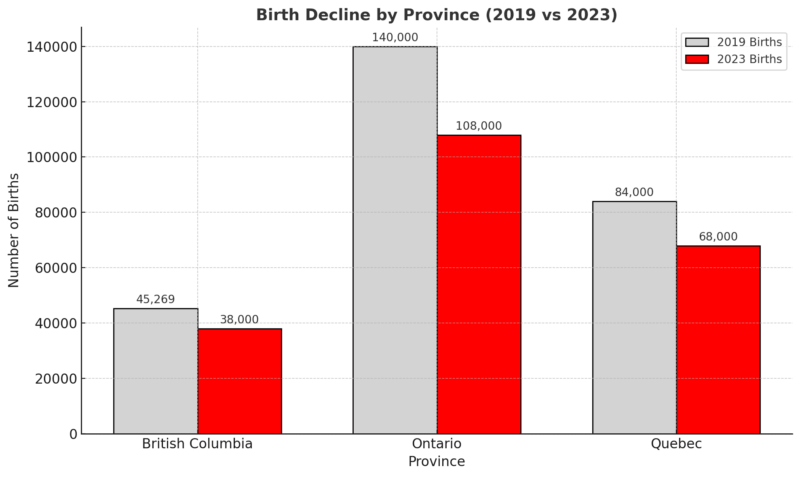British Columbia has experienced the sharpest drop in births in the last five years, with live births down about 16%, falling below 40,000 a year for the first time since 1979. Ontario and Quebec aren’t far behind, both reporting double-digit percentage declines and a steep slide in fertility rates.
For context, Canada’s total fertility rate hit an all-time low of just 1.26 children per woman in 2023, compared to 1.47 in 2019
The story isn’t just about a gentle, gradual decline. Since 2019, the pace of change has accelerated. According to Statistics Canada, there were just over 351,000 live births nationwide in 2023—a number that’s been dropping by several thousand per year.
The dip between 2021 and 2022 alone was a dramatic 5%, and the latest numbers suggest the trend is picking up steam.
By the Numbers: Which Provinces Saw the Biggest Drop?
Let’s look at the provinces making headlines for declining births. Here’s a side-by-side snapshot of the three with the sharpest declines, based on the most recent public data:
Birth Decline by Province (2019–2023)

So what does this look like in practice? In BC, births have fallen by about 7,000 per year since 2019—enough to make a real dent in school enrollments, future workforce numbers, and even the housing market.
Why Is This Happening?
It’s not just one thing—it’s a perfect storm. Here’s what researchers, economists, and demographers are pointing to, with deeper stats and context.
1. Delayed Parenthood
The average age of Canadian mothers at first birth is now over 31.7 years—a striking increase from 26.7 years in 1976. In British Columbia, Ontario, and Quebec, the average climbs even higher in major cities like Vancouver, Toronto, and Montreal.
Delayed parenthood naturally reduces the window for having multiple children, and women who start families after 30 are statistically more likely to have just one or two children.
2. High Cost of Living and Housing
Housing prices in Vancouver and Toronto are now among the highest in North America. As of 2024, the average home price in Greater Vancouver is over $1.2 million, while Toronto isn’t far behind. Even rent for a one-bedroom apartment averages above $2,300/month in both cities.
Childcare can cost families another $10,000–$20,000 per year, depending on the city and age of the child. These costs put huge financial pressure on young families and directly influence decisions about whether—and when—to have kids.
3. Changing Priorities and Social Norms
Young Canadians today are more likely than previous generations to pursue higher education. In 2023, over 70% of adults aged 25–34 had a postsecondary certificate, diploma, or degree, up from about 55% in 2000 (Statistics Canada, 2023). With more time spent in school, people are entering the workforce and starting families later.
Social expectations have shifted too—more Canadians are living alone, cohabitating without marriage, or choosing to remain child-free. The classic “two kids and a house in the suburbs” dream just isn’t the default anymore.
4. COVID-19’s Lingering Effects
The pandemic didn’t just disrupt the economy; it shifted priorities and created deep uncertainty. After a small “baby rebound” in 2021, birth numbers dropped again as families faced rising inflation, job insecurity, and uncertainty about the future.
In 2022, live births in Canada fell by about 5% compared to the previous year. Many who delayed parenthood during COVID have continued to wait or decided not to have additional children.
Key Factors Behind Falling Births in Canada
Factor
Recent Statistics/Trends
Impact on Birth Rate
Avg. age at first birth
31.7 years (2023, up from 26.7 in 1976)
Fewer children per family
Vancouver avg. home price
$1.2 million+ (2024)
Delayed/limited families
Childcare cost (per year)
$10,000–$20,000
High financial barrier
Postsecondary education (25–34)
70%+ with a credential (2023)
Delayed family formation
National birth rate 2022–2023
–5% in one year
Accelerating decline
Not Just a BC, Ontario, or Quebec Story: A Truly National Decline
While headlines tend to focus on British Columbia, Ontario, and Quebec—thanks to their size and their steep drops in both births and fertility rates—the reality is that every part of Canada is feeling the impact of this demographic shift.
According to Statistics Canada, 10 of the country’s 13 provinces and territories recorded all-time low fertility rates in 2022. That means that from the Maritimes to the Prairies, and from Northern Canada down to the Pacific, fewer babies are being born than at almost any point in the nation’s modern history (Statistics Canada, 2024).
Table: Fertility Rate (TFR) 2022, Selected Provinces & Territories

These figures show that even provinces with smaller populations, or those historically known for higher fertility rates—like the Prairies and Northern Territories—are also experiencing record declines.
What’s Driving the National Pattern?
It’s the same mix of factors affecting BC, Ontario, and Quebec—delayed parenthood, soaring living and housing costs, changing social values, and the ongoing effects of the pandemic. In places like Atlantic Canada, economic migration and an aging population have amplified the decline.
Rural regions aren’t immune either; younger people move to cities for work or education and may not return to start families, leaving behind shrinking schools and local economies under pressure.
A growing number of Canadians are also making more intentional choices about whether and when to have children. Increased access to family planning, modern contraception, and even awareness around issues like the Paragard IUD Lawsuit have influenced some couples’ decisions, either by giving more control over fertility or, in rare cases, raising concerns about the side effects or risks associated with certain contraceptives.
While the lawsuit itself centers on complications with a specific IUD, its widespread publicity has contributed to broader conversations about reproductive health, choice, and access in Canada. This greater awareness, combined with delayed partnership and changing attitudes, means more Canadians are exercising agency over when or if they start a family.
Final Thoughts
Canada’s birth rate has dropped to its lowest level in recorded history.
READ MORE: https://t.co/qjDRqa8fohhttps://t.co/qjDRqa8foh
— Globalnews.ca (@globalnews) January 31, 2024
The sharp decline in births across Canada—especially in British Columbia, Ontario, and Quebec—is rewriting the country’s demographic future.
The numbers are clear, the reasons are complex, and the impact will touch everything from schools and housing to healthcare and public finances.
Whether you’re a policymaker, parent, student, or just someone curious about what’s coming next, this is a trend that will shape the Canadian story for years to come.












